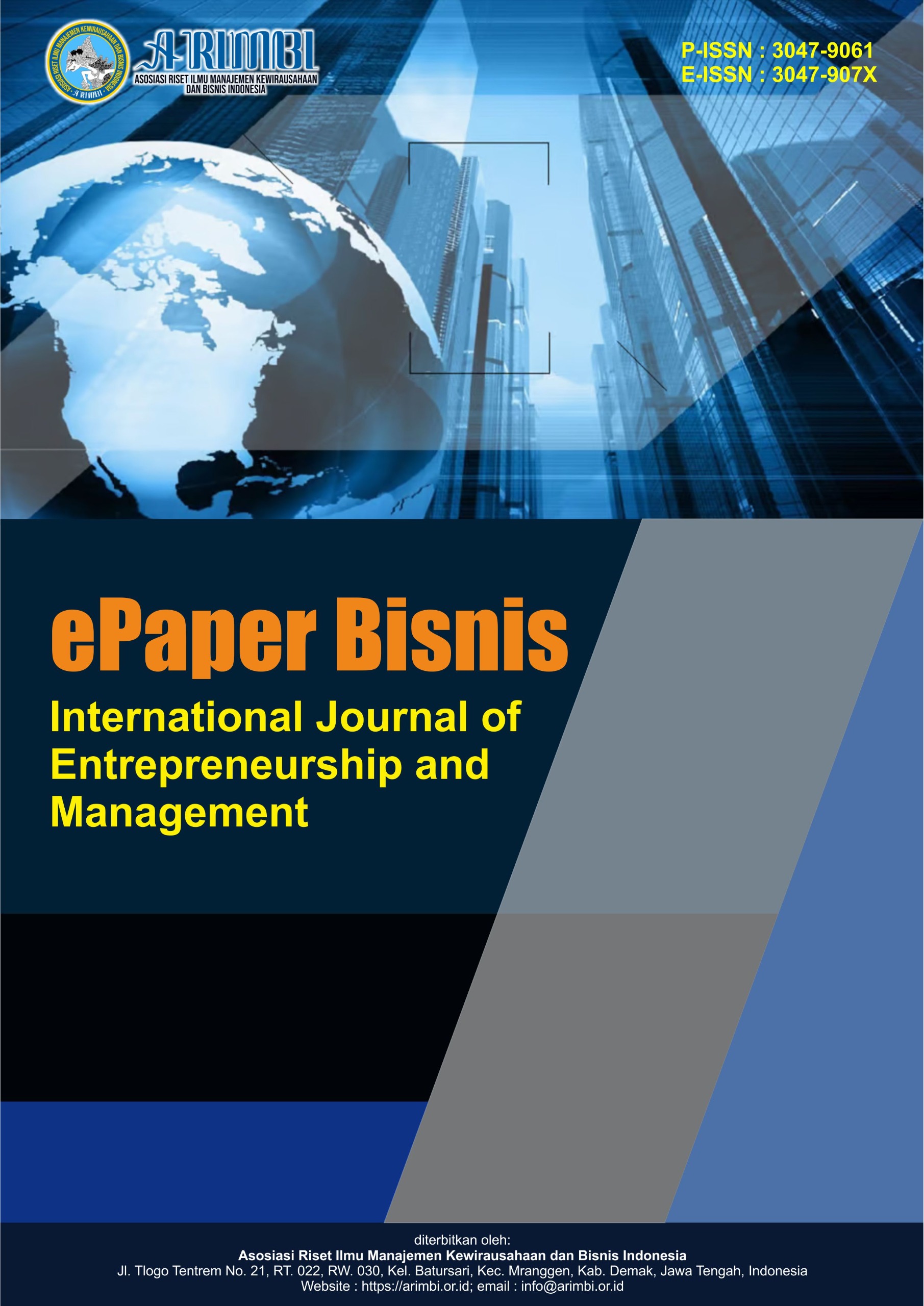Analysis of The Effectiveness Level of Trans Sarbagita Bus as Public Transport in Denpasar City
DOI:
https://doi.org/10.61132/epaperbisnis.v2i2.393Keywords:
accessibility, punctuality, service effectiveness, ticket price, Trans Sarbagita BusAbstract
Public transportation is a primary necessity for supporting daily activities in Denpasar City. One mode of transport that plays a strategic role is the Trans Sarbagita Bus. As a mass transportation service, this bus system is expected to provide effective, efficient, and affordable mobility. This study aims to analyze: (1) public perception of the effectiveness of the Trans Sarbagita Bus service; (2) the simultaneous effect of accessibility, punctuality, and ticket price on service effectiveness; (3) the partial effect of each of these variables; and (4) the strengths, weaknesses, opportunities, and threats (SWOT) of the Trans Sarbagita Bus system. A quantitative method with an associative approach was employed. Data were collected from 105 active respondents through observation, interviews, and a five-point Likert scale questionnaire, and analyzed using multiple linear regression via SPSS. The findings show that: (1) public perception is generally positive, especially in terms of comfort and safety, although accessibility and punctuality remain suboptimal; (2) accessibility, punctuality, and ticket price simultaneously have a significant effect on service effectiveness; (3) each of these variables also has a positive and significant partial effect; and (4) strengths lie in low fares and safety, while key weaknesses include limited access and delays. Opportunities stem from policy support and rising public awareness, whereas threats include the dominance of private vehicles and low intermodal integration. It is recommended that the government enhance public transport campaigns through media and community partnerships, as well as expand bus stop access and intermodal connectivity to improve service effectiveness.
Downloads
References
Adinda, R., & Rahayu, S. (2023). Konsep efektivitas dan aplikasinya dalam manajemen.
Jakarta: Pustaka Ilmiah.
Ananda, R. (2021). Pengaruh Aksesibilitas terhadap Kepuasan Pengguna Transportasi Umum.
Jurnal Transportasi dan Mobilitas, 5(2), 123-134.
Badan Pusat Statistik. (2020). Sensus Penduduk 2020. Jakarta: Badan Pusat Statistik.
Badan Pusat Statistik. (2024). Data migrasi dan kependudukan Provinsi Bali. Jakarta: Badan Pusat Statistik.
Bidari, A., Nugroho, H., & Santoso, D. (2021). Strategi organisasi berbasis analisis SWOT dalam menghadapi persaingan bisnis. Jurnal Manajemen Bisnis, 12(3), 45-58.
Brady, M. K., & Cronin, J. J. (2001). Some new thoughts on conceptualizing perceived service quality: A hierarchical approach. Journal of Marketing, 65(3), 34-49.
Browne, C. (2017). Youth migration and education: Motivations and consequences. Journal of Migration Studies, 10(2), 123-140.
Chen, L., Wijaya, R., & Santoso, P. (2023). Transportasi publik yang efektif dalam mendukung mobilitas masyarakat. Jurnal Transportasi Indonesia, 9(1), 22-35.
Emalisa, R. (2003). Migrasi internal dan pola pemukiman di Indonesia. Jurnal Kependudukan dan Pengembangan, 7(1), 45-59.
Handayani, S., & Sutrisno, B. (2023). Strategi Penetapan Harga Tiket Transportasi Umum di Indonesia. Jurnal Ekonomi dan Bisnis, 11(1), 45-58.
Kanwal, S., Aslam, R., & Ahmed, Z. (2020). Market efficiency and the role of information: Evidence from emerging markets. International Journal of Economics and Finance, 12(7), 112-124.
Kurniawan, F., Pratama, B., & Yuliana, S. (2024). Analisis SWOT untuk strategi pengembangan usaha kecil dan menengah. Jurnal Manajemen Strategis, 15(1), 77-89.
Lee, E. S. (1966). A theory of migration. Demography, 3(1), 47-57.
Mani, A., & Kumar, S. (2021). Gender differences in migration patterns: Human capital and employment outcomes. Synthesa Journal, 15(3), 210-225.
Mantra, I. B. P. (2003). Perilaku mobilitas penduduk dan hukum-hukum migrasi. Denpasar: Universitas Udayana Press.
Mislawaty, M., Hasanah, U., & Fauzi, A. (2022). Konsep pelayanan publik dalam konteks pemerintahan Indonesia. Jurnal Administrasi Publik, 8(2), 99-110.
Mobogunje, A. (dalam Sudibia, I. G. A. et al., 2012). Peranan migran terdahulu dalam membantu migran baru. Jurnal Sosiologi Indonesia, 9(1), 35-48.
Munir, A. (2011). Rintangan antara dan pengaruh jarak terhadap migrasi. Jurnal Geografi Indonesia, 9(2), 85-96.
Nasution, M. K., & Purba, E. (2022). Metode analisis SWOT dalam perencanaan strategis organisasi. Jurnal Ilmu Manajemen, 10(4), 150-162.
Nugroho, T. (2020). Ketepatan Waktu dalam Pelayanan Transportasi Publik: Studi Kasus Bus Kota. Jurnal Manajemen Operasional, 7(3), 78-89.
Parasuraman, A., Zeithaml, V. A., & Berry, L. L. (1988). SERVQUAL: A multiple-item scale for measuring consumer perceptions of service quality. Journal of Retailing, 64(1), 12- 40.
Pramudito, A. (2025). Manajemen Jadwal dan Efektivitas Layanan Transportasi. Prosiding Seminar Nasional Transportasi, 2(1), 101-110.
Putri, M. (2021). Dampak Harga Tiket Terhadap Penggunaan Transportasi Umum. Jurnal Studi Transportasi, 6(4), 210-220.
Rachmawati, N. (2018). Faktor-faktor yang mempengaruhi migrasi ekonomi di Indonesia.
Jurnal Ekonomi Pembangunan, 19(2), 98-109.
Raharjo, H., Santoso, W., & Hidayat, R. (2022). Dinamika pasar: Teori penawaran dan permintaan serta aplikasinya dalam ekonomi modern. Jurnal Ekonomi dan Bisnis, 14(3), 101-115.
Sudibia, I. G. A., Prasetya, A. H., & Suardana, I. K. (2012). Migrasi dan adaptasi sosial di kota- kota besar Indonesia. Denpasar: Universitas Udayana Press.
Sugiyono. (2017). Metode penelitian kuantitatif, kualitatif dan R&D. Bandung: Alfabeta.
Sun, Y., Chen, X., & Liu, W. (2020). The unique characteristics of services and their impact on service quality management. Service Business, 14(2), 345-360.
Synthesa, A. (2021). Dinamika migrasi dan investasi modal manusia di Indonesia. Synthesa Publishing.
Todaro, M. P., & Smith, S. C. (2010). Economic development (11th ed.). Boston: Pearson Education.
Wulandari, F., & Hakim, R. (2023). Analisis Ketepatan Waktu Layanan Transportasi Publik.
Jurnal Sistem Transportasi, 12(1), 89-99.
Yuliana, P. (2025). Fairness Pricing pada Layanan Transportasi Umum. Jurnal Ekonomi Transportasi, 8(1), 134-145.
Zubaidah, S., Haryanto, S., & Suhardi. (2016). Pengaruh migrasi terhadap perkembangan ekonomi daerah. Jurnal Ilmu Ekonomi dan Pembangunan, 16(2), 156-169.
Downloads
Published
How to Cite
Issue
Section
License
Copyright (c) 2025 ePaper Bisnis : International Journal of Entrepreneurship and Management

This work is licensed under a Creative Commons Attribution-ShareAlike 4.0 International License.




